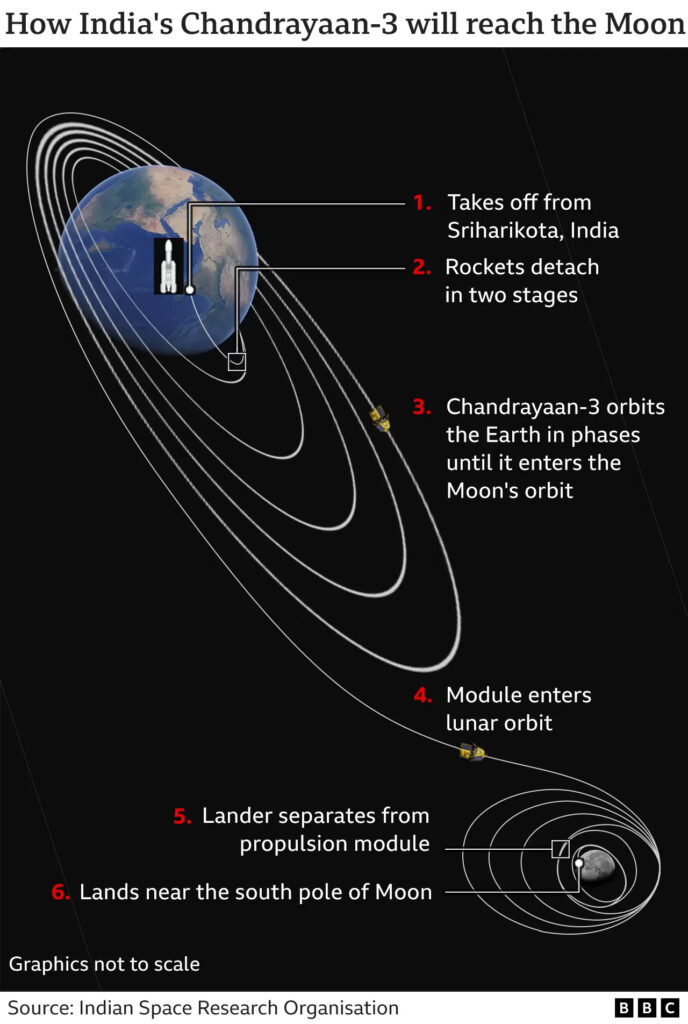India’s space agency has released the first images of the Moon taken by the Chandrayaan-3 spacecraft, which entered lunar orbit on Saturday.
The images show craters on lunar surface getting larger and larger as the spacecraft draws closer.
Chandrayaan-3’s lander and rover are due to reach the surface on 23 August.
If successful, India will be the first country to perform a controlled “soft landing” near the south pole.
It will also become only the fourth to achieve a soft landing on the Moon after the US, the former Soviet Union and China.
After the spacecraft orbited the Earth for about 10 days, it was sent into the translunar orbit last Tuesday and successfully injected into the lunar orbit on Saturday.
Indian Space Research Agency (Isro) said that all checks showed that Chandrayaan-3 was in good “health”.
It has also pointed out that “this is the third time in succession that Isro has successfully injected a spacecraft into the lunar orbit”.
Scientists say Chandrayaan-3, the third in India’s programme of lunar exploration, is expected to build on the success of its earlier Moon missions.
It comes 15 years after the country’s first Moon mission in 2008, which discovered the presence of water molecules on the parched lunar surface and established that the Moon has an atmosphere during daytime.
Chandrayaan-2 – which also comprised an orbiter, a lander and a rover – was launched in July 2019 but it was only partially successful. Its orbiter continues to circle and study the Moon even today, but the lander-rover failed to make a soft landing and crashed during touchdown.

Isro chief Sreedhara Panicker Somanath has said India’s space agency had carefully studied the data from its crash and carried out simulation exercises to fix the glitches in Chandrayaan-3, which weighs 3,900kg and cost 6.1bn rupees ($75m; £58m).
The lander (called Vikram, after the founder of Isro) weighs about 1,500kg and carries within its belly the 26kg rover which is named Pragyaan, the Sanskrit word for wisdom.
Now that the craft has entered the Moon’s orbit, scientists will begin reducing the rocket’s speed gradually to bring it to a point which will allow a soft landing for Vikram.
“A series of manoeuvres have been planned to gradually reduce the spacecraft’s orbit and position it over the lunar poles,” says Isro.
“After some manoeuvres, the propulsion module will separate from the lander while in orbit. Then a series of complex braking manoeuvres will be executed to facilitate a soft landing in the South Pole region of the Moon on 23 August,” it adds.
Once it lands, the six-wheeled rover will eject and roam around the rocks and craters on the Moon’s surface, gathering crucial data and images to be sent back to Earth for analysis.
“The rover is carrying five instruments which will focus on finding out about the physical characteristics of the surface of the Moon, the atmosphere close to the surface and the tectonic activity to study what goes on below the surface. I’m hoping we’ll find something new,” Mr Somanath has said.
The south pole of the Moon is still largely unexplored – the surface area that remains in shadow there is much larger than that of the Moon’s north pole, and scientists say it means there is a possibility of water in areas that are permanently shadowed.

Source : BBC


